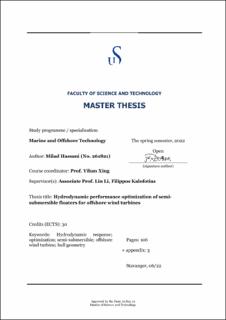| dc.description.abstract | Floating structures have become viable alternatives for supporting wind turbines as offshore wind projects move deeper into the water. The wind is prevalent in deep water (depths > 60 m) all around the world. Because of the amount of potential at these depths, wind turbines will require the design of a floating platform, as current wind turbines are usually fixed at the bottom and rely on ordinary concrete with a gravity base, which is not practical at these depths. Floating offshore wind offers a huge potential for green energy production offshore and the overall energy transition to zero carbon emission in general. With the development of even larger wind turbines in the range beyond 15 MW, the floating concepts become more attractive and competitive from a cost perspective. However, larger turbines and cost optimization also require a re-thinking of established solutions and concepts. New ideas and innovations are required to optimize floating offshore wind farms further.
An approach for the optimization of semi-submersible floaters using different surrogate models has been developed in this thesis. A semi-submersible floater is selected and designed to support a 15-MW wind turbine in the North Sea. The optimization framework consists of automatic modeling and numerical simulations in open-source tools as well as obtaining the Pareto fronts using surrogate models and the Genetic Algorithm in CEASES software. A Python-SALOME-NEMOH interface is used to obtain the hydrodynamic properties for geometries defined by various variables. The geometries are subjected to three performance constraints: the static platform pitch, metacentric height, nacelle acceleration, and wind. Loads in operating and parked conditions are considered. Finally, the geometries are optimized using two objective functions related to material cost and nacelle acceleration, and the results are discussed. This work contributes to developing efficient design optimization methods for floating structures. | |
